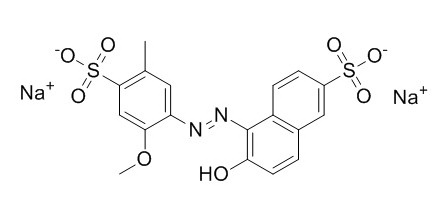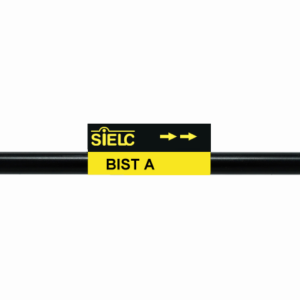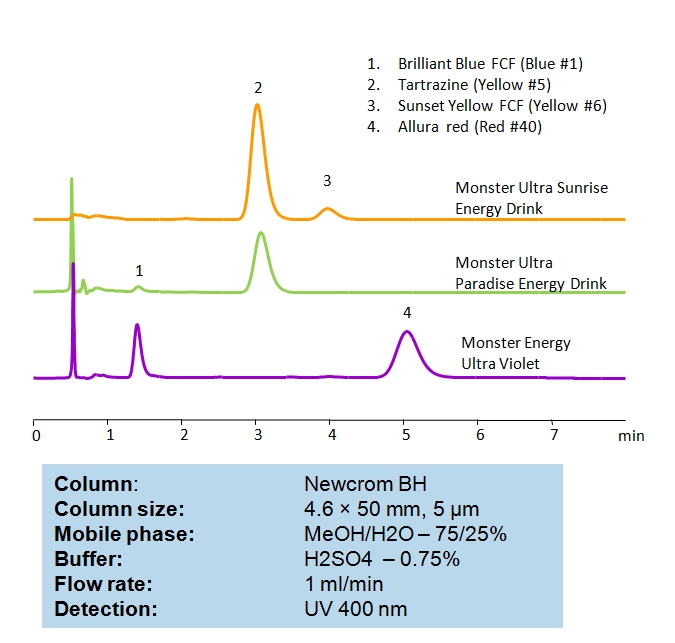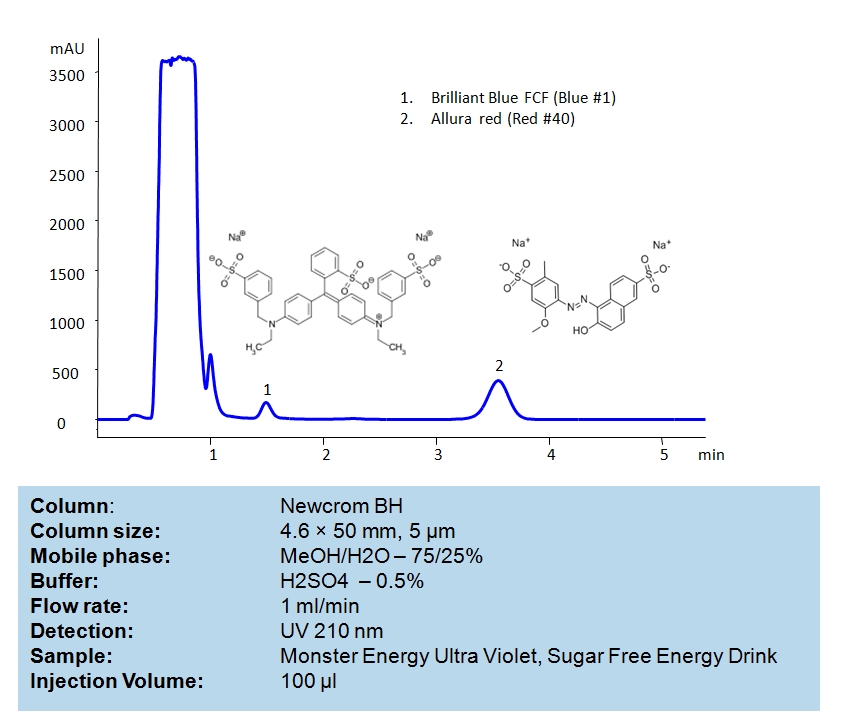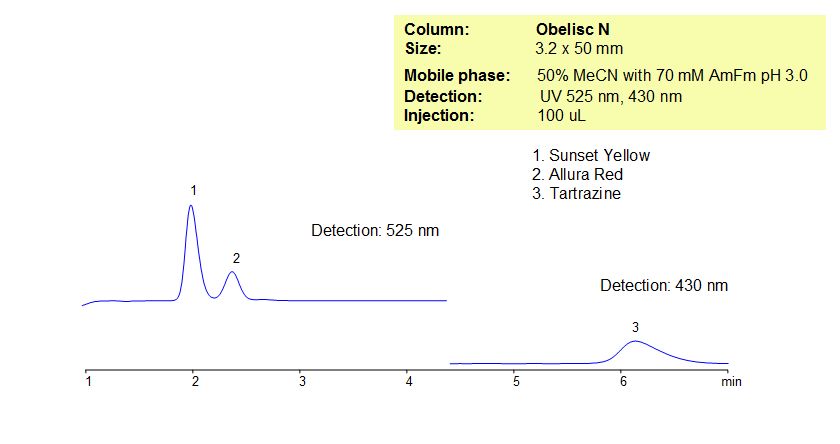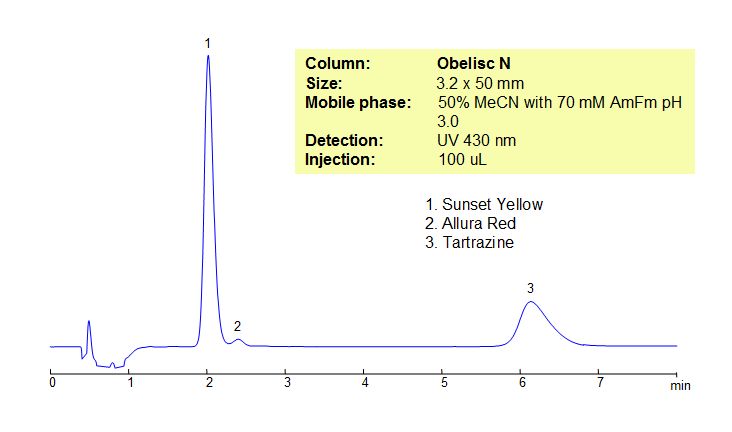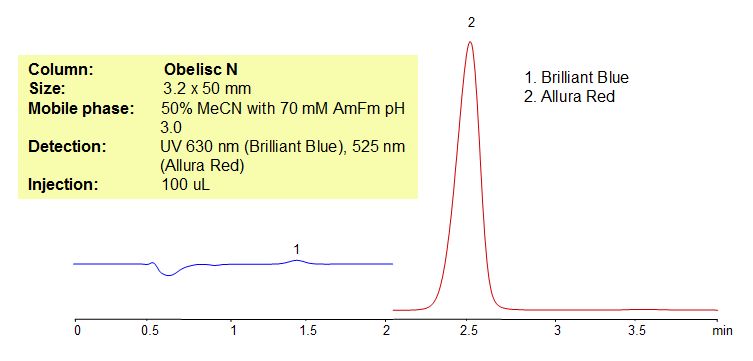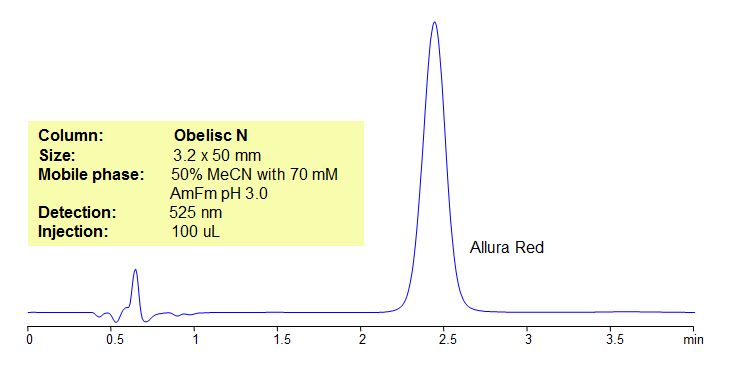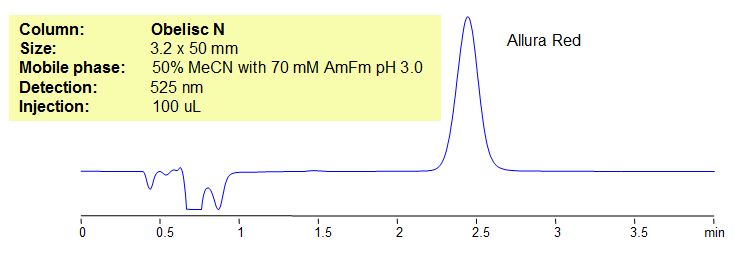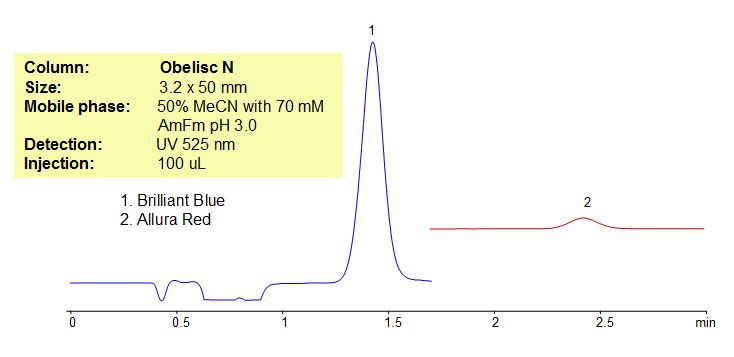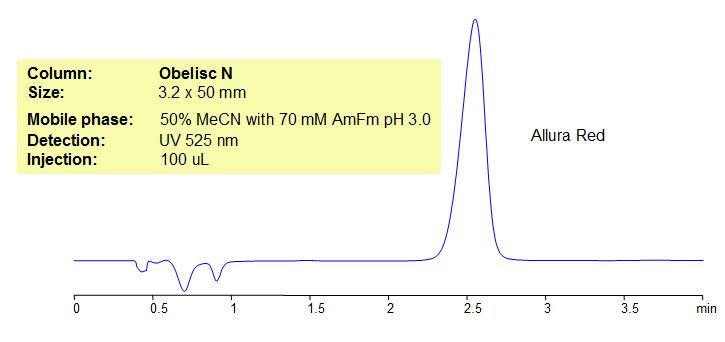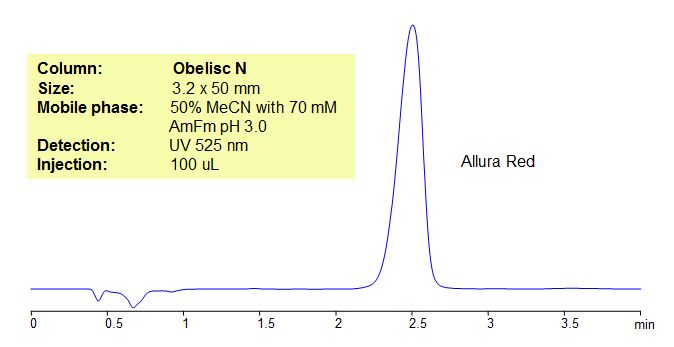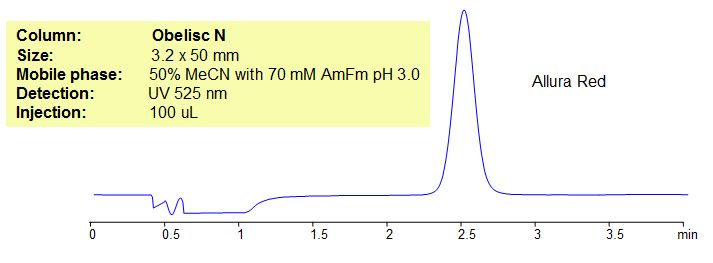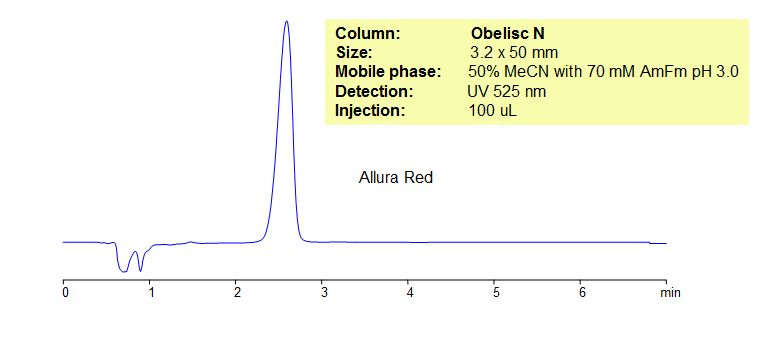| CAS Number | 25956-17-6 |
|---|---|
| Molecular Formula | C18H14N2Na2O8S2 |
| Molecular Weight | 496.420 |
| InChI Key | CEZCCHQBSQPRMU-LLIZZRELSA-L |
| LogP | 1.56 |
| Synonyms |
|
Applications:
HPLC Method for Analysis of Allura Red, Sunset Yellow FCF, Tartrazine, and Brilliant Blue FCF in Nerds Gummy Clusters Rainbow on BIST A Column
July 28, 2025
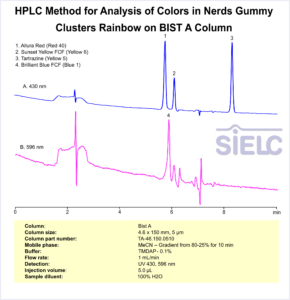
Allura Red AC, also known as FD&C Red No. 40, is a red azo dye that is the most commonly used red dye in the United States. It is used anywhere from tattoos to children’s’ medications to drinks and food. If used in food it also has the E number E129. Allura red is sold as a dark red sodium salt, but when dissolved in water, the solution appears orange-red. Sunset Yellow FCF, also known as Orange Yellow S, C.I. 15985, or Yellow 6, is a petroleum-derived orange azo dye. When in powder form, it is Reddish-orange, but when dissolved in water, the liquid becomes bright yellow. The dye is banned or restricted in Norway, Finland and Sweden. Brilliant Blue FCF, also known as Blue 1, is an compound classified as a triarylmethane dye. Dry, it has the appearance of a light-blue powder, but when dissolved in water, turns deeper blue.
Tartrazine is a yellow food coloring agent. It’s a polar trisodium salt, and like most very polar compounds it exhibits very weak to no interaction with traditional reverse phase columns. Additionally, multi-charged compounds such as Tartrazine tend to have a broad peak shape using single mode ion-exchange columns and often require large quantities of a buffer in the mobile phase due to very strong ionic interactions. By using a mixed-mode column, specifically designed in mind for multiple charges, BIST A can retain and separate dyes with perfect peak shape using a mobile phase of Acetonitrile (MeCN) and water with N,N,N’,N’-Tetramethyl-1,3-propanediamine (TMDAP). UV detection at 430 and 596 nm.
High Performance Liquid Chromatography (HPLC) Method for Analysis of Allura Red (Red #40), Sunset Yellow (Yellow 6), Tartrazine (FD&C Yellow 5), Brilliant Blue FCF (Blue 1) on BIST A Column.
| Column | BIST A, 4.6 x 150 mm, 5 µm, 100 A, dual ended |
| Mobile Phase | MeOH – Gradient from 80-25% for 10 minutes |
| Buffer | TMDAP – 0.1% |
| Flow Rate | 1.0 ml/min |
| Detection | UV 430, 596 nm |
| Class of Compounds | Acid, Dyes |
| Analyzing Compounds | Allura Red (Red #40), Sunset Yellow (Yellow 6), Tartrazine (FD&C Yellow 5), Brilliant Blue FCF (Blue 1) |
Application Column
BIST A
Column Diameter: 4.6 mm
Column Length: 150 mm
Particle Size: 5 µm
Pore Size: 100 A
Column options: dual ended
Brilliant Blue FCF (Blue 1)
Sunset Yellow (Yellow 6)
Tartrazine (FD&C Yellow 5)
Vis Detection

UV-Vis Spectrum of Allura Red (Red 40)
July 24, 2025
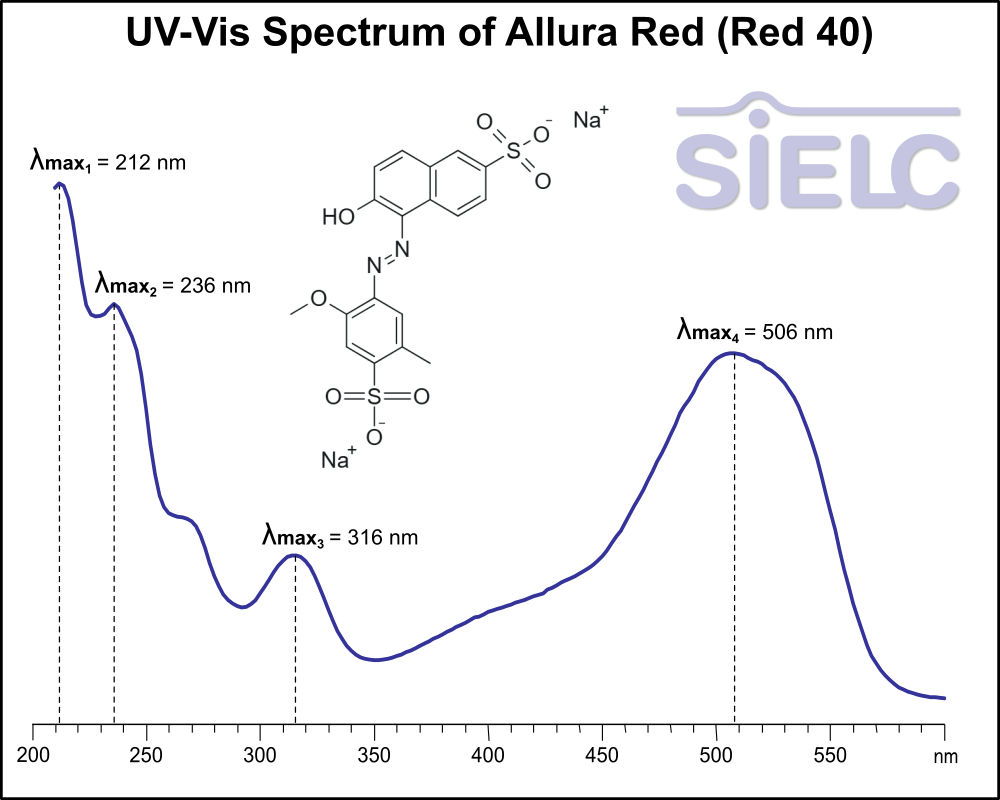
If you are looking for optimized HPLC method to analyze Allura Red (Red #40) check our HPLC Applications library
For optimal results in HPLC analysis, it is recommended to measure absorbance at a wavelength that matches the absorption maximum of the compound(s) being analyzed. The UV spectrum shown can assist in selecting an appropriate wavelength for your analysis. Please note that certain mobile phases and buffers may block wavelengths below 230 nm, rendering absorbance measurement at these wavelengths ineffective. If detection below 230 nm is required, it is recommended to use acetonitrile and water as low UV-transparent mobile phases, with phosphoric acid and its salts, sulfuric acid, and TFA as buffers.
For some compounds, the UV-Vis Spectrum is affected by the pH of the mobile phase. The spectra presented here are measured with an acidic mobile phase that has a pH of 3 or lower.

HPLC Method for Analysis of Allura Red (FD&C Red 40, E129) on a BIST A Column
November 30, 2022
HPLC Method for Allura Red (Red #40) on BIST A by SIELC Technologies
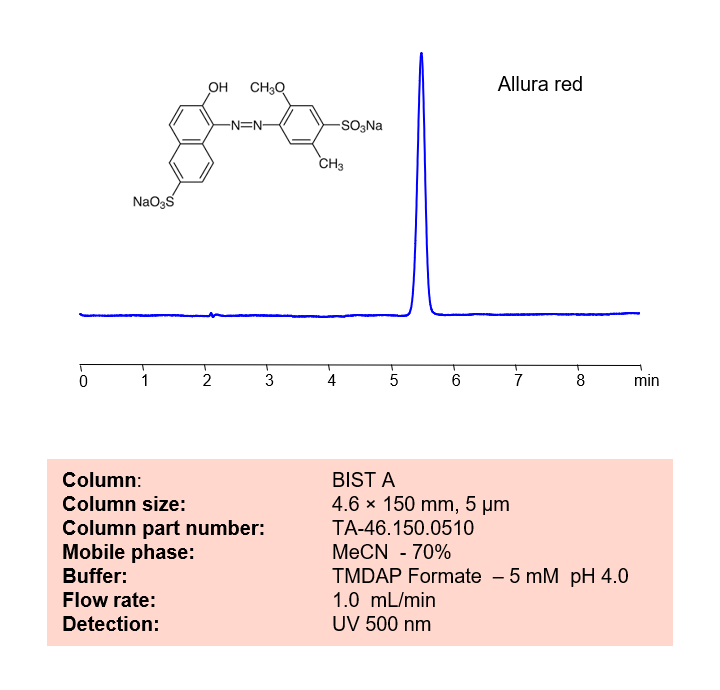
Allura Red AC, also known as FD&C Red No. 40, is a red azo dye that is the most commonly used red dye in the United States. It is used anywhere from tattoos to children’s’ medications to drinks and food. If used in food it also has the E number E129. Allura red is sold as a dark red sodium salt, but when dissolved in water, the solution appears orange-red.
Using SIELC’s newly introduced BIST™ method, Allura Red (Red #40) which ionizes in water, can be retained on a negatively-charged, cation-exchange BIST A column. There are two keys to this retention method: 1) a multi-charged, positive buffer, such as N,N,N’,N’-Tetramethyl-1,3-propanediamine (TMDAP), which acts as a bridge, linking the negatively-charged Acid Red 1 analytes to the negatively-charged column surface and 2) a mobile phase consisting mostly of organic solvent (such as MeCN) to minimize the formation of a solvation layer around the charged analytes. Using this new and unique analysis method, Allura Red can be retained and UV detected at 500 nm.
Condition
| Column | BIST A, 4.6 x 150 mm, 5 µm, 100 A, dual ended |
| Mobile Phase | MeCN |
| Buffer | TMDAP phosphate – 5 mM pH 4.0 |
| Flow Rate | 2.0 mL/min |
| Detection | Vis 600 nm |
Description
| Class of Compounds | Dyes |
| Analyzing Compounds | Allura Red (Red #40) |
Application Column
BIST A
Column Diameter: 4.6 mm
Column Length: 150 mm
Particle Size: 5 µm
Pore Size: 100 A
Column options: dual ended

HPLC Method for Analysis of Brilliant Blue FCF Tartrazine, Sunset Yellow FCF and Allura Red in Monster Energy Drinks on Newcrom BH Column
July 14, 2020
HPLC Method for Brilliant Blue FCF (Blue 1), Tartrazine (FD&C Yellow 5), Sunset Yellow (Yellow 6), Allura Red (Red #40) on Newcrom BH by SIELC Technologies
High Performance Liquid Chromatography (HPLC) Method for Analysis of Brilliant Blue FCF (Blue 1), Tartrazine (FD&C Yellow 5), Sunset Yellow (Yellow 6), Allura Red (Red #40).
Brilliant Blue FCF, also known as Blue 1, is an compound classified as a triarylmethane dye. Dry, it has the appearance of a light-blue powder, but when dissolved in water, turns deeper blue.
Allura Red AC, also known as FD&C Red No. 40, is a red azo dye that is the most commonly used red dye in the United States. It is used anywhere from tattoos to children’s’ medications to drinks and food. If used in food it also has the E number E129. Allura red is sold as a dark red sodium salt, but when dissolved in water, the solution appears orange-red.
Sunset Yellow FCF, also known as Orange Yellow S, C.I. 15985, or Yellow 6, is a petroleum-derived orange azo dye. When in powder form, it is Reddish-orange, but when dissolved in water, the liquid becomes bright yellow.The dye is banned or restricted in Norway, Finland and Sweden.
Tartrazine is a yellow food coloring agent. It’s a trisodium salt, and like many multi-charged molecules tends to exhibit significant tailing using reverse-phase HPLC columns.
By using a mixed-mode column, specifically designed in mind for multiple charges, Newcrom BH can retain and separate dyes with perfect peak shape using a mobile phase of methanol (MeOH) and water with sulfuric acid (H2SO4) to facilitate ion-exchange. UV detection at 400nm.
You can find detailed UV spectra of Blue 1 and information about its various lambda maxima by visiting the following link.
You can find detailed UV spectra of Red 40 and information about its various lambda maxima by visiting the following link.
You can find detailed UV spectra of Yellow 6 and information about its various lambda maxima by visiting the following link.
You can find detailed UV spectra of Yellow 5 and information about its various lambda maxima by visiting the following link.
| Column | Newcrom BH, 4.6 x 50 mm, 5 µm, 100 A, dual ended |
| Mobile Phase | MeOH/H2O – 75/25% |
| Buffer | H2SO4 – 0.75% |
| Flow Rate | 1.0 ml/min |
| Detection | UV 400 nm |
| Class of Compounds | Acid, Dyes |
| Analyzing Compounds | Brilliant Blue FCF (Blue 1), Tartrazine (FD&C Yellow 5), Sunset Yellow (Yellow 6), Allura Red (Red #40) |
Application Column
Newcrom BH
Column Diameter: 4.6 mm
Column Length: 50 mm
Particle Size: 5 µm
Pore Size: 100 A
Column options: dual ended
Brilliant Blue FCF (Blue 1)
Sunset Yellow (Yellow 6)
Tartrazine (FD&C Yellow 5)

HPLC Method for Analysis of Brilliant Blue FCF and Allura Red in Monster Energy Ultra Violet, Sugar Free Energy Drink
July 2, 2020
HPLC Method for Brilliant Blue FCF (Blue 1), Allura Red (Red #40) on Newcrom BH by SIELC Technologies
High Performance Liquid Chromatography (HPLC) Method for Analysis of Brilliant Blue FCF (Blue 1), Allura Red (Red #40).
Brilliant Blue FCF (Blue 1) is a synthetic molecule used as a food coloring agent. Allura Red (Red 40) is another food colorant. Both are present in Monster Energy Ultra Violet sugar free drink. Both are disodium salts and can be separated in HPLC by our Newcrom BH mixed-mode column which utilizes both hydrophobic and ion-exchange properties. The mobile phase is methanol (MeOH) and water with sulfuric acid (H2SO4) buffer making the method MS-compatible. Can also be UV detected at 210nm
You can find detailed UV spectra of Blue 1 and information about its various lambda maxima by visiting the following link.
You can find detailed UV spectra of Red 40 and information about its various lambda maxima by visiting the following link.
| Column | Newcrom BH, 4.6 x 50 mm, 5 µm, 100 A, dual ended |
| Mobile Phase | MeOH/H2O – 75/25% |
| Buffer | H2SO4 – 0.5%% |
| Flow Rate | 1.0 ml/min |
| Detection | UV 210 nm |
| Class of Compounds | Acid, Dyes |
| Analyzing Compounds | Brilliant Blue FCF (Blue 1), Allura Red (Red #40) |
Application Column
Newcrom BH
Column Diameter: 4.6 mm
Column Length: 50 mm
Particle Size: 5 µm
Pore Size: 100 A
Column options: dual ended
Brilliant Blue FCF (Blue 1)

HPLC Method for Analysis of Allura Red, Sunset Yellow, Tartrazine in Mountain Dew Live Wire at 2 Wavelengths
March 29, 2017
Sunset Yellow FCF, also known as Orange Yellow S, C.I. 15985, or Yellow 6, is a petroleum-derived orange azo dye. When in powder form, it is Reddish-orange, but when dissolved in water, the liquid becomes bright yellow. The dye is banned or restricted in Norway, Finland and Sweden. Obelisc N is a column with very polar characteristics. It contains embedded acidic and basic ionizable groups and can retain Sunset Yellow. The method is LC/MS and UV compatible and can be used as a general approach for analyzing similar compounds.
| Column | Obelisc N, 3.2×50 mm, 5 µm, 100A |
| Mobile Phase | MeCN/H2O – 50/50% |
| Buffer | AmFm pH 3.0 – 70 mM |
| Flow Rate | 0.6 ml/min |
| Detection | UV, 430, 525 nm |
| Class of Compounds |
Dye, Acid, Hydrophilic, Ionizable, Zwitterionic |
| Analyzing Compounds | Allura Red, Sunset Yellow, Tartrazine |
Application Column
Obelisc N
SIELC has developed the Obelisc™ columns, which are mixed-mode and utilize Liquid Separation Cell technology (LiSC™). These cost-effective columns are the first of their kind to be commercially available and can replace multiple HPLC columns, including reversed-phase (RP), AQ-type reversed-phase, polar-embedded group RP columns, normal-phase, cation-exchange, anion-exchange, ion-exclusion, and HILIC (Hydrophilic Interaction Liquid Chromatography) columns. By controlling just three orthogonal method parameters - buffer concentration, buffer pH, and organic modifier concentration - users can adjust the column properties with pinpoint precision to separate complex mixtures.
Select optionsHPLC Method for Analysis of Allura Red in Children’s Mucinex Multi-Syptom Cold
HPLC Method for Analysis of Allura Red in Robitussin Cough & Cold
HPLC Method for Analysis of Allura Red in Soft Drinks 2
HPLC Method for Analysis of Allura Red in Soft Drinks 3
HPLC Method for Analysis of Allura Red in Soft Drinks 4
HPLC Method for Analysis of Allura Red in Soft Drinks 5
HPLC Method for Analysis of Allura Red, Sunset Yellow, Tartrazine in Mountain Dew Live Wire at 1 Wavelength
HPLC Method for Analysis of Brilliant Blue and Allura Red in Children’s Mucinex Night Time Multi-Symptom Cold
Sunset Yellow (Yellow 6)
Tartrazine (FD&C Yellow 5)

HPLC Method for Analysis of Allura Red, Sunset Yellow, Tartrazine in Mountain Dew Live Wire at 1 Wavelength
March 29, 2017
Sunset Yellow FCF, also known as Orange Yellow S, C.I. 15985, or Yellow 6, is a petroleum-derived orange azo dye. When in powder form, it is Reddish-orange, but when dissolved in water, the liquid becomes bright yellow.The dye is banned or restricted in Norway, Finland and Sweden. Obelisc N is a column with very polar characteristics. It contains embedded acidic and basic ionizable groups and can retain Sunset Yellow. The method is LC/MS and UV compatible and can be used as a general approach for analyzing similar compounds.
| Column | Obelisc N, 3.2×50 mm, 5 µm, 100A |
| Mobile Phase | MeCN/H2O – 50/50% |
| Buffer | AmFm pH 3.0 – 70 mM |
| Flow Rate | 0.6 ml/min |
| Detection | UV, 430 nm |
| Class of Compounds |
Dye, Acid, Hydrophilic, Ionizable, Zwitterionic |
| Analyzing Compounds | Allura Red, Sunset Yellow, Tartrazine |
Application Column
Obelisc N
SIELC has developed the Obelisc™ columns, which are mixed-mode and utilize Liquid Separation Cell technology (LiSC™). These cost-effective columns are the first of their kind to be commercially available and can replace multiple HPLC columns, including reversed-phase (RP), AQ-type reversed-phase, polar-embedded group RP columns, normal-phase, cation-exchange, anion-exchange, ion-exclusion, and HILIC (Hydrophilic Interaction Liquid Chromatography) columns. By controlling just three orthogonal method parameters - buffer concentration, buffer pH, and organic modifier concentration - users can adjust the column properties with pinpoint precision to separate complex mixtures.
Select optionsHPLC Method for Analysis of Allura Red in Children’s Mucinex Multi-Syptom Cold
HPLC Method for Analysis of Allura Red in Robitussin Cough & Cold
HPLC Method for Analysis of Allura Red in Soft Drinks 2
HPLC Method for Analysis of Allura Red in Soft Drinks 3
HPLC Method for Analysis of Allura Red in Soft Drinks 4
HPLC Method for Analysis of Allura Red in Soft Drinks 5
HPLC Method for Analysis of Allura Red, Sunset Yellow, Tartrazine in Mountain Dew Live Wire at 2 Wavelengths
HPLC Method for Analysis of Brilliant Blue and Allura Red in Children’s Mucinex Night Time Multi-Symptom Cold

HPLC Method for Analysis of Dyes in Walgreen’s Night Time Cough
March 29, 2017
| Column | Obelisc N, 3.26×50 mm, 5 µm, 100A |
| Mobile Phase | MeCN/H2O – 50/50% |
| Buffer | AmFm pH 3.0 – 70 mM |
| Flow Rate | 0.6 ml/min |
| Detection | UV, 630, 525 nm |
| Class of Compounds |
Dye, Acid, Hydrophilic, Ionizable, Zwitterionic |
| Analyzing Compounds | Allura Red, Brilliant Blue |
Application Column
Obelisc N
SIELC has developed the Obelisc™ columns, which are mixed-mode and utilize Liquid Separation Cell technology (LiSC™). These cost-effective columns are the first of their kind to be commercially available and can replace multiple HPLC columns, including reversed-phase (RP), AQ-type reversed-phase, polar-embedded group RP columns, normal-phase, cation-exchange, anion-exchange, ion-exclusion, and HILIC (Hydrophilic Interaction Liquid Chromatography) columns. By controlling just three orthogonal method parameters - buffer concentration, buffer pH, and organic modifier concentration - users can adjust the column properties with pinpoint precision to separate complex mixtures.
Select optionsBrilliant Blue FCF (Blue 1)

HPLC Method for Analysis of Allura Red in Robitussin Cough & Cold
March 29, 2017
Sunset Yellow FCF, also known as Orange Yellow S, C.I. 15985, or Yellow 6, is a petroleum-derived orange azo dye. When in powder form, it is Reddish-orange, but when dissolved in water, the liquid becomes bright yellow.The dye is banned or restricted in Norway, Finland and Sweden. Obelisc N is a column with very polar characteristics. It contains embedded acidic and basic ionizable groups and can retain Sunset Yellow. The method is LC/MS and UV compatible and can be used as a general approach for analyzing similar compounds.
| Column | Obelisc N, 3.2×50 mm, 5 µm, 100A |
| Mobile Phase | MeCN/H2O – 50/50% |
| Buffer | AmFm pH 3.0 – 70 mM |
| Flow Rate | 0.6 ml/min |
| Detection | UV, 525 nm |
| Class of Compounds |
Dye, Acid, Hydrophilic, Ionizable, Zwitterionic |
| Analyzing Compounds | Allura Red |
Application Column
Obelisc N
SIELC has developed the Obelisc™ columns, which are mixed-mode and utilize Liquid Separation Cell technology (LiSC™). These cost-effective columns are the first of their kind to be commercially available and can replace multiple HPLC columns, including reversed-phase (RP), AQ-type reversed-phase, polar-embedded group RP columns, normal-phase, cation-exchange, anion-exchange, ion-exclusion, and HILIC (Hydrophilic Interaction Liquid Chromatography) columns. By controlling just three orthogonal method parameters - buffer concentration, buffer pH, and organic modifier concentration - users can adjust the column properties with pinpoint precision to separate complex mixtures.
Select optionsHPLC Method for Analysis of Allura Red in Children’s Mucinex Multi-Syptom Cold
HPLC Method for Analysis of Allura Red in Soft Drinks 2
HPLC Method for Analysis of Allura Red in Soft Drinks 3
HPLC Method for Analysis of Allura Red in Soft Drinks 4
HPLC Method for Analysis of Allura Red in Soft Drinks 5
HPLC Method for Analysis of Allura Red, Sunset Yellow, Tartrazine in Mountain Dew Live Wire at 1 Wavelength
HPLC Method for Analysis of Allura Red, Sunset Yellow, Tartrazine in Mountain Dew Live Wire at 2 Wavelengths
HPLC Method for Analysis of Brilliant Blue and Allura Red in Children’s Mucinex Night Time Multi-Symptom Cold

HPLC Method for Analysis of Allura Red in Children’s Mucinex Multi-Syptom Cold
March 29, 2017
Sunset Yellow FCF, also known as Orange Yellow S, C.I. 15985, or Yellow 6, is a petroleum-derived orange azo dye. When in powder form, it is Reddish-orange, but when dissolved in water, the liquid becomes bright yellow. The dye is banned or restricted in Norway, Finland and Sweden. Obelisc N is a column with very polar characteristics. It contains embedded acidic and basic ionizable groups and can retain Sunset Yellow. The method is LC/MS and UV compatible and can be used as a general approach for analyzing similar compounds.
| Column | Obelisc N, 3.2×50 mm, 5 µm, 100A |
| Mobile Phase | MeCN/H2O – 50/50% |
| Buffer | AmFm pH 3.0 – 70 mM |
| Flow Rate | 0.6 ml/min |
| Detection | UV, 525 nm |
| Class of Compounds |
Dye, Acid, Hydrophilic, Ionizable, Zwitterionic |
| Analyzing Compounds | Allura Red |
Application Column
Obelisc N
SIELC has developed the Obelisc™ columns, which are mixed-mode and utilize Liquid Separation Cell technology (LiSC™). These cost-effective columns are the first of their kind to be commercially available and can replace multiple HPLC columns, including reversed-phase (RP), AQ-type reversed-phase, polar-embedded group RP columns, normal-phase, cation-exchange, anion-exchange, ion-exclusion, and HILIC (Hydrophilic Interaction Liquid Chromatography) columns. By controlling just three orthogonal method parameters - buffer concentration, buffer pH, and organic modifier concentration - users can adjust the column properties with pinpoint precision to separate complex mixtures.
Select optionsHPLC Method for Analysis of Allura Red in Robitussin Cough & Cold
HPLC Method for Analysis of Allura Red in Soft Drinks 2
HPLC Method for Analysis of Allura Red in Soft Drinks 3
HPLC Method for Analysis of Allura Red in Soft Drinks 4
HPLC Method for Analysis of Allura Red in Soft Drinks 5
HPLC Method for Analysis of Allura Red, Sunset Yellow, Tartrazine in Mountain Dew Live Wire at 1 Wavelength
HPLC Method for Analysis of Allura Red, Sunset Yellow, Tartrazine in Mountain Dew Live Wire at 2 Wavelengths
HPLC Method for Analysis of Brilliant Blue and Allura Red in Children’s Mucinex Night Time Multi-Symptom Cold

HPLC Method for Analysis of Brilliant Blue and Allura Red in Children’s Mucinex Night Time Multi-Symptom Cold
March 29, 2017
Brilliant Blue FCF, also known as Blue 1, is an compound classified as a triarylmethane dye. Dry, it has the appearance of a light-blue powder, but when dissolved in water, turns deeper blue. But Allura Red AC, also known as FD&C Red No. 40, is a red azo dye that is the most commonly used red dye in the United States. It is used anywhere from tattoos to children’s’ medications to drinks and food. If used in food it also has the E number E129. Allura red is sold as a dark red sodium salt, but when dissolved in water, the solution appears orange-red.Obelisc N is a column with very polar characteristics. It contains embedded acidic and basic ionizable groups and can retain Allura Red adn Brilliant Blue. The method is LC/MS and UV compatible and can be used as a general approach for analyzing similar compounds.
Application Column
Obelisc N
SIELC has developed the Obelisc™ columns, which are mixed-mode and utilize Liquid Separation Cell technology (LiSC™). These cost-effective columns are the first of their kind to be commercially available and can replace multiple HPLC columns, including reversed-phase (RP), AQ-type reversed-phase, polar-embedded group RP columns, normal-phase, cation-exchange, anion-exchange, ion-exclusion, and HILIC (Hydrophilic Interaction Liquid Chromatography) columns. By controlling just three orthogonal method parameters - buffer concentration, buffer pH, and organic modifier concentration - users can adjust the column properties with pinpoint precision to separate complex mixtures.
Select optionsHPLC Method for Analysis of Allura Red in Children’s Mucinex Multi-Syptom Cold
HPLC Method for Analysis of Allura Red in Robitussin Cough & Cold
HPLC Method for Analysis of Allura Red in Soft Drinks 2
HPLC Method for Analysis of Allura Red in Soft Drinks 3
HPLC Method for Analysis of Allura Red in Soft Drinks 4
HPLC Method for Analysis of Allura Red in Soft Drinks 5
HPLC Method for Analysis of Allura Red, Sunset Yellow, Tartrazine in Mountain Dew Live Wire at 1 Wavelength
HPLC Method for Analysis of Allura Red, Sunset Yellow, Tartrazine in Mountain Dew Live Wire at 2 Wavelengths

HPLC Method for Analysis of Allura Red in Sparkling Ice Cherry Limeade
March 29, 2017

HPLC Method for Analysis of Allura Red in Powerade Zero Fruit Punch
March 29, 2017

HPLC Method for Analysis of Allura Red in Soft Drinks 5
March 27, 2017
| Column | Obelisc N, 3.2×50 mm, 5 µm, 100A |
| Mobile Phase | MeCN/H2O – 50/50% |
| Buffer | AmFm pH 3.0 – 70 mM |
| Flow Rate | 0.6 ml/min |
| Detection | UV, 525 nm |
| Class of Compounds |
Dye, Acid, Hydrophilic, Ionizable, Zwitterionic |
| Analyzing Compounds | Allura Red |
Application Column
Obelisc N
SIELC has developed the Obelisc™ columns, which are mixed-mode and utilize Liquid Separation Cell technology (LiSC™). These cost-effective columns are the first of their kind to be commercially available and can replace multiple HPLC columns, including reversed-phase (RP), AQ-type reversed-phase, polar-embedded group RP columns, normal-phase, cation-exchange, anion-exchange, ion-exclusion, and HILIC (Hydrophilic Interaction Liquid Chromatography) columns. By controlling just three orthogonal method parameters - buffer concentration, buffer pH, and organic modifier concentration - users can adjust the column properties with pinpoint precision to separate complex mixtures.
Select options
HPLC Method for Analysis of Allura Red in Soft Drinks 3
March 27, 2017
| Column | Obelisc N, 3.2×50 mm, 5 µm, 100A |
| Mobile Phase | MeCN/H2O – 50/50% |
| Buffer | AmFm pH 3.0 – 70 mM |
| Flow Rate | 0.6 ml/min |
| Detection | UV, 525 nm |
| Class of Compounds |
Dye, Acid, Hydrophilic, Ionizable, Zwitterionic |
| Analyzing Compounds | Allura Red |
Application Column
Obelisc N
SIELC has developed the Obelisc™ columns, which are mixed-mode and utilize Liquid Separation Cell technology (LiSC™). These cost-effective columns are the first of their kind to be commercially available and can replace multiple HPLC columns, including reversed-phase (RP), AQ-type reversed-phase, polar-embedded group RP columns, normal-phase, cation-exchange, anion-exchange, ion-exclusion, and HILIC (Hydrophilic Interaction Liquid Chromatography) columns. By controlling just three orthogonal method parameters - buffer concentration, buffer pH, and organic modifier concentration - users can adjust the column properties with pinpoint precision to separate complex mixtures.
Select options
